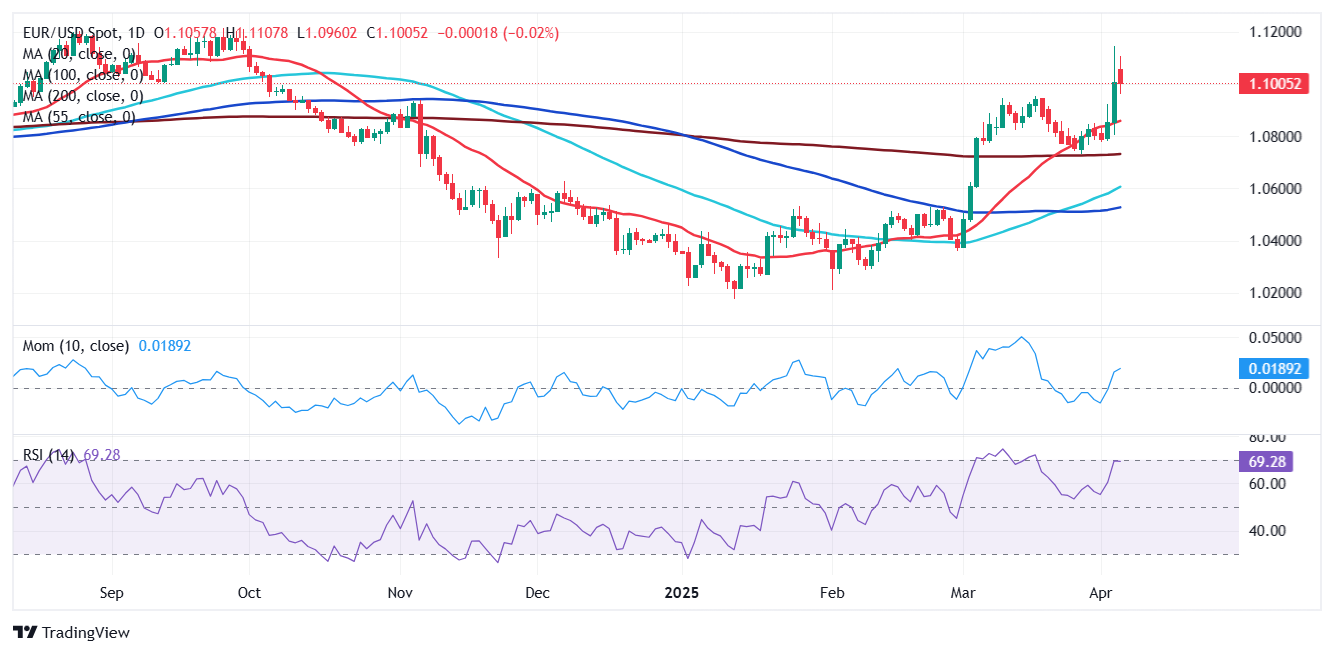- United States President Donald Trump announced widespread reciprocal tariffs on Wednesday.
- Financial markets collapsed with Wall Street suffering its worst losses since the 2020 pandemic.
- The EUR/USD pair retreated from highs but has scope to recover its bullish strength.
Financial markets navigated tumultuous waters in the first week of April. United States (US) President Donald Trump finally unveiled his reciprocal tariffs plan and spurred panic among worldwide investors. The EUR/USD pair peaked at 1.1146 mid-week, its highest since September 2024, amid broad US Dollar (USD) weakness, to finally settle at around 1.1000.
Trump’s tariffs triggered chaos
Speaking at the Rose Garden on Wednesday, US President Trump unveiled details on widespread levies. He presented lists of tariffs that different countries supposedly charge on the US, alongside the taxes the US will add to such countries. Later, it was revealed that the calculations are based on a country’s goods trade deficit with the US, by calculating the percentage difference between exports and imports, then dividing by two.
Trump imposed a baseline 10% reciprocal tariff on over 180 countries, with much steeper levies on some of America’s biggest trading partners, such as an additional 34% on China, 20% on the European Union (EU), 24% on Japan and 32% on Taiwan. Such taxes will come into effect between April 5 and April 9.
Trump said on Thursday he would be open to negotiations as long as they offer the US something “phenomenal.” Panic, however, did not recede as previously to his comments, several White House officials said that the newly announced reciprocal tariffs were not negotiable. Contradictions kept uncertainty at record levels ahead of the weekly close.
Wall Street collapsed, suffering losses last seen in 2020 on Thursday, while the picture worsened heading into the weekend. US indexes maintained the negative route in the last trading day of the week, with the Dow Jones Industrial Average (DJIA) shedding over 1,000 points for a second consecutive day.
Retaliation coming up next
European authorities did not hesitate to respond. European Commission President Ursula von der Leyen said that the global economy “will massively suffer,” expressing concerns about rising inflation and resurgent protectionism. Von der Leyen added that they would work toward reducing barriers, not raising them, yet made it clear that failure to negotiate will lead to counter-tariffs.
Additionally, German Vice Chancellor and Economic Affairs Minister Robert Habeck noted: “For American consumers, this day will not be a 'Liberation Day' but an 'Inflation Day.’”
China also announced retaliatory measures, with levies matching the 34% announced by the US on all American goods coming into effect on April 10. Meanwhile, the United Kingdom (UK) and some Asian countries opened negotiations to reduce the impact of tariffs.
By the end of the week, financial markets remain on edge. Commodities are down alongside equities, while the USD holds on to weekly losses, unevenly across the FX board. Safe-haven Japanese Yen (JPY) and Swiss Franc (CHF) are the clearer winners alongside the Pound Sterling (GBP), as the US hit the UK with the minimum tax.
Fears of widespread recession and higher inflationary pressures will likely dominate the upcoming days’ headlines. The US Dollar is likely to remain weak despite the late recovery driven by profit-taking ahead of the weekend rather than confidence in the American currency.
Generally speaking, the chaotic picture is set to continue, unless Trump backs up, which seems highly unlikely, while fueled by retaliatory announcements.
Macro data keeps being ignored
On the data front, it is worth mentioning that German inflation was softer than anticipated in March, according to preliminary estimates. The Harmonized Index of Consumer Prices (HICP) rose 2.3% year-on-year (YoY), below the previous 2.6% and the 2.4% anticipated by market participants. The EU annualized core HICP was up 2.4%, easing from the 2.6% posted in February and below the 2.5% anticipated by market players.
Across the pond, the ISM Purchasing Managers Indexes (PMI) and employment data showed the US economy is far from a recession, despite mounting fears about it. The ISM Manufacturing PMI resulted at 49.0 in March, although a contraction was already anticipated. Services output was worse than anticipated, with the index down to 50.8 from 53.5 in February.
As per US employment figures, the picture was mixed. The ADP Employment Change report showed that the private sector added 155K new positions in March, beating the 105K expected. Additionally, the March Challenger Job Cuts report showed that the number of layoffs soared to record levels, only surpassed by those reported in the first months of the Covid-related shutdowns. US-based employers announced 275,240 job cuts in the month, a 60% increase from the 172,017 cuts announced in February. It is worth noting that furloughs in the federal government totaled 216,215 for the month as part of the new Department of Government Efficiency's effort to pare down the federal workforce.
Job openings declined in February according to the JOLTS report, down to 7.56 million from the previous 7.76 million.
Finally, the US March Nonfarm Payrolls report showed the country added a total of 228K new jobs in the month, much better than the 135K expected. The Unemployment Rate ticked higher, to 4.2%, while wage-related inflation eased by more than anticipated.
In the upcoming days, the macroeconomic calendar will feature the Federal Open Market Committee (FOMC) Meeting Minutes and the US March Consumer Price Index (CPI). The country will also release the Producer Price Index (PPI) for the same month and the preliminary estimate of the April Michigan Consumer Sentiment Index. As for the EU, the most relevant release will be February Retail Sales.
EUR/USD technical outlook
The EUR/USD pair trimmed half of its weekly gains but still trades roughly 200 pips above its opening on Friday. Technical readings in the weekly chart show that the bullish momentum remains strong, with technical indicators heading firmly north well above their midlines. Even further, a flat 100 Simple Moving Average (SMA) at around 1.0780 provided support, while the pair ran past the 200 SMA. Finally, the 20 SMA turned higher well below the longer ones, reflecting buyers’ determination.
In the daily chart, the EUR/USD pair trades well above all its moving averages, with the 20 SMA maintaining its bullish slope above the longer ones, currently at around 1.0860. Technical indicators turned south, reflecting the intraday slide, yet remain within positive levels, still far from suggesting a steeper slide ahead.
A break through the 1.0900 figure should deny the bullish case in the upcoming days, with 1.0860 and 1.0800 acting as the next support levels. The battle around 1.1000 is likely to continue until the pair clears the 1.1050 area. Beyond it, 1.1100 and 1.1145 are the next levels to watch.

Tariffs FAQs
Tariffs are customs duties levied on certain merchandise imports or a category of products. Tariffs are designed to help local producers and manufacturers be more competitive in the market by providing a price advantage over similar goods that can be imported. Tariffs are widely used as tools of protectionism, along with trade barriers and import quotas.
Although tariffs and taxes both generate government revenue to fund public goods and services, they have several distinctions. Tariffs are prepaid at the port of entry, while taxes are paid at the time of purchase. Taxes are imposed on individual taxpayers and businesses, while tariffs are paid by importers.
There are two schools of thought among economists regarding the usage of tariffs. While some argue that tariffs are necessary to protect domestic industries and address trade imbalances, others see them as a harmful tool that could potentially drive prices higher over the long term and lead to a damaging trade war by encouraging tit-for-tat tariffs.
During the run-up to the presidential election in November 2024, Donald Trump made it clear that he intends to use tariffs to support the US economy and American producers. In 2024, Mexico, China and Canada accounted for 42% of total US imports. In this period, Mexico stood out as the top exporter with $466.6 billion, according to the US Census Bureau. Hence, Trump wants to focus on these three nations when imposing tariffs. He also plans to use the revenue generated through tariffs to lower personal income taxes.
Information on these pages contains forward-looking statements that involve risks and uncertainties. Markets and instruments profiled on this page are for informational purposes only and should not in any way come across as a recommendation to buy or sell in these assets. You should do your own thorough research before making any investment decisions. FXStreet does not in any way guarantee that this information is free from mistakes, errors, or material misstatements. It also does not guarantee that this information is of a timely nature. Investing in Open Markets involves a great deal of risk, including the loss of all or a portion of your investment, as well as emotional distress. All risks, losses and costs associated with investing, including total loss of principal, are your responsibility. The views and opinions expressed in this article are those of the authors and do not necessarily reflect the official policy or position of FXStreet nor its advertisers. The author will not be held responsible for information that is found at the end of links posted on this page.
If not otherwise explicitly mentioned in the body of the article, at the time of writing, the author has no position in any stock mentioned in this article and no business relationship with any company mentioned. The author has not received compensation for writing this article, other than from FXStreet.
FXStreet and the author do not provide personalized recommendations. The author makes no representations as to the accuracy, completeness, or suitability of this information. FXStreet and the author will not be liable for any errors, omissions or any losses, injuries or damages arising from this information and its display or use. Errors and omissions excepted.
The author and FXStreet are not registered investment advisors and nothing in this article is intended to be investment advice.
Recommended Content
Editors’ Picks

EUR/USD trims losses and approaches 1.1380
The US Dollar now succumbs to the re-emergence of the selling pressure and allows EUR/USD to recoup part of the ground lost and approach to the 1.1380 zone on Thursday. Earlier on Thursday, the ECB matched estimates and lowered its rates by 25 bps.

GBP/USD extends the daily recovery, looks at 1.3300
The upside impulse in the British pound remains everything but abated and now propels GBP/USD to the upper end of the range, shifting its attention to recent yearly peaks near 1.3300 the figure.

Gold breaks below $3,300, daily troughs
Further improvement in the sentiment surrounding the risk-associated universe put Gold prices to the test on Thursday. Indeed, the troy ounce of the precious metal faces increasing downside pressure and breaches the key $3,300 mark to hit new daily lows.

Crypto market cap fell more than 18% in Q1, wiping out $633.5 billion after Trump’s inauguration top
CoinGecko’s Q1 Crypto Industry Report highlights that the total crypto market capitalization fell by 18.6% in the first quarter, wiping out $633.5 billion after topping on January 18, just a couple of days ahead of US President Donald Trump’s inauguration.

Future-proofing portfolios: A playbook for tariff and recession risks
It does seem like we will be talking tariffs for a while. And if tariffs stay — in some shape or form — even after negotiations, we’ll likely be talking about recession too. Higher input costs, persistent inflation, and tighter monetary policy are already weighing on global growth.

The Best brokers to trade EUR/USD
SPONSORED Discover the top brokers for trading EUR/USD in 2025. Our list features brokers with competitive spreads, fast execution, and powerful platforms. Whether you're a beginner or an expert, find the right partner to navigate the dynamic Forex market.